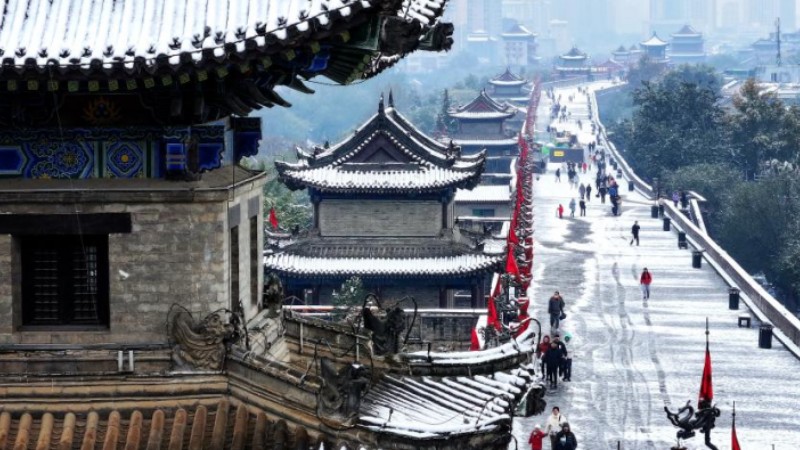Meeting Challenges with Unity of Purpose To Write a New Chapter for Asia-Pacific Cooperation
Meeting Challenges with Unity of Purpose
To Write a New Chapter for Asia-Pacific Cooperation
Written Speech by H.E. Xi Jinping
President of the People’s Republic of China
At the APEC CEO Summit
San Francisco, November 16, 2023
Representatives of the Business Community,
Ladies and Gentlemen,
Friends,
It gives me great pleasure to be invited to address the APEC CEO Summit. I visited San Francisco many years ago, and I was deeply impressed by the openness, inclusiveness and creativity which this beautiful city is famous for.
Three decades ago, where humanity should be headed in the post-Cold War era was the question of the world, of history and of the times in front of Asia-Pacific leaders. In response, they followed the trend toward peace and development, and convened the inaugural APEC Economic Leaders’ Meeting. They agreed unanimously to rise above the outdated mentality of bloc confrontation and zero-sum game, deepen economic cooperation and integration in the region, and build a dynamic, harmonious and prosperous Asia-Pacific community. This major decision enabled Asia-Pacific development and economic globalization to embark on a fast track of growth, turning the region into a powerhouse for world economic growth, an anchor of stability for global development, and a pacesetter for international cooperation. There is so much we can draw from this remarkable journey of Asia-Pacific cooperation.
—Openness and inclusiveness are the defining feature of Asia-Pacific cooperation. Development in our region has been achieved not through provoking antagonism and confrontation, pursuing a beggar-thy-neighbor policy, or erecting high fences around a small yard, but by staying open and inclusive and drawing on each other’s strengths. We have stayed committed to open regionalism, jointly formulated the Bogor Goals and the Putrajaya Vision, promoted trade and investment liberalization and facilitation, and bolstered economic integration of the region. Over the past three decades, the Asia-Pacific has cut its average tariff rate from 17 percent to 5 percent, and contributed 70 percent of global economic growth.
—Development for all is the overarching goal of Asia-Pacific cooperation. Development is an eternal pursuit in our region. We have stayed focused on development and continually deepened economic and technical cooperation, thus strengthening the ability of developing members to achieve self-development. We jointly developed “the APEC Approach” based on the principles of voluntarism, consensus-building and incremental progress, and we respect the right to development of all members. Over the past three decades, per capita income in the Asia-Pacific has more than quadrupled, and one billion people have been lifted out of poverty. This is an important contribution to human progress and global sustainable development.
—Seeking common ground while shelving differences is the best practice of Asia-Pacific cooperation. Economies in the region have different histories and cultures and are in different stages of development.
Forcing uniformity will not advance cooperation in the region; seeking common ground while shelving differences is the right way forward. Over the past three decades, we have properly tackled major challenges such as the Asian and international financial crises, and have sustained the momentum of economic development in the Asia-Pacific. Our success was possible because we have followed the underlying trend, kept the larger picture in mind, and capitalized on the spirit of partnership featuring harmony without uniformity, and solidarity and mutual assistance. This has enabled us to turn diversity in membership into momentum for cooperation and make collective progress through tapping into complementarity.
Ladies and Gentlemen,
Friends,
The world has entered a new period of turbulence and change. The momentum of world economic growth is sluggish. Destabilizing, uncertain and unpredictable factors are increasing. Where will Asia-Pacific cooperation be headed in the next 30 years? This is a new question of the times facing us. As an ancient Chinese scholar observed, “Plants with strong roots grow well, and efforts with the right focus ensure success.” We should stay committed to APEC’s founding mission, never forget our mission bestowed by history, and move to relaunch Asia-Pacific cooperation.
San Francisco, where the United Nations Charter was signed, embodies the noble aspiration of all peoples for peace across the world. Peace does not come by easily, and development is a long and arduous task. We should jointly uphold the purposes and principles of the U.N. Charter, and follow the right norms for state-to-state relations to maintain Asia-Pacific prosperity and stability through dialogue and partnership rather than confrontation and alliance. The region cannot and should not be an arena for geopolitical rivalry, still less should it be plunged into a new cold war or camp-based confrontation.
The story of Asia-Pacific prosperity and development shows that development is only possible with cooperation, absence of cooperation is the biggest risk, and that decoupling and supply-chain disruption are not in anyone’s interests. We should remain committed to open regionalism, and steadfastly advance the building of a Free Trade Area of the Asia-Pacific. We should respect laws governing economic development, bring out the best in each and every one of us, make our economies more interconnected, strengthen synergy between relevant regional trade agreements and development strategies, and build an open Asia-Pacific economy featuring win-win cooperation.
Facing a new wave of scientific and technological revolution and industrial transformation, we should look beyond the horizon, seize the opportunities, and move along with the trend to promote transition to digital, smart and green development. We should jointly boost innovation and market application of scientific and technological advances, and push forward full integration of digital and physical economies. We should jointly improve global governance of science and technology, bolster support for green and digital transition and sustainable development through innovation, and build an open, fair, just and non-discriminatory environment for the development of science and technology.
Ten years ago, I called for building a community with a shared future for mankind. The APEC Putrajaya Vision explicitly lays out its vision for an Asia-Pacific community by 2040, charting the course for further cooperation in our region. In recent years, in response to the pressing needs around the world, I have proposed the Global Development Initiative (GDI), the Global Security Initiative (GSI) and the Global Civilization Initiative (GCI). They are intended to galvanize all stakeholders to address global challenges, promote common development, and improve the well-being of humanity. China will work with all in the Asia-Pacific to advance and implement these initiatives, and build an open, inclusive, clean and beautiful world of lasting peace, universal security and shared prosperity.
Ladies and Gentlemen,
Friends,
This year, China’s economy has been steadily recovering and turning for the better. Its growth rate is among the highest among major economies of the world. And solid gains have been made in our pursuit of high-quality development. China remains the most powerful engine of global growth, and will generate one-third of global growth this year. Just as some leaders of the business community have said, China has become a synonym of the best investment destination, and that the “next China” is still China. We invite friends from business communities across the world to invest and deepen your footprint in China.
China enjoys distinct strengths such as a socialist market economy in systemic terms, a supersize market in terms of demand, a full-fledged industrial system in terms of supply, and abundant, high-caliber labor forces and entrepreneurs in terms of human resources. China’s economic development is self-generative, resilient and has many potentials. In the past, China surmounted numerous difficulties and obstacles by defusing risks and meeting challenges, and made historic achievements. Today, the overall Chinese economy, blessed by its strong resilience, enormous potential and ample room for maneuver, remains promising, and it will remain so in the long run. We have the confidence in, and even more capability of achieving long-term and stable growth, and through our development we will continue to provide the world with new growth momentum and opportunities.
China is committed to applying the new development philosophy with a focus on achieving innovative, coordinated, green and open development for all, and it is pursuing high-quality development and high value-added and green economic growth. Recent years have seen rapid growth in China’s export of “the new three,” namely, new energy vehicles, lithium-ion batteries and photovoltaic products. A national voluntary greenhouse gas emissions reduction trading market will soon be launched, which will create huge green market opportunities. China will expedite its efforts to modernize the industrial system, provide better institutional safeguards to enable business entities of all types to share in the gains of development, and foster new drivers of growth and create more room for development.
We remain committed to pursuing development with our doors open. We will unswervingly advance high-standard opening up and further expand market access. China has announced the removal of all restrictive measures on foreign investment in manufacturing. The sixth China International Import Expo was held recently, and the second Global Digital Trade Expo will be held later this month. All these steps will expand China’s opening up and create more development opportunities and benefits for other countries. China is applying high standards to its implementation of the Regional Comprehensive Economic Partnership Agreement. It is working to align itself with the high-standard economic and trade rules of the Comprehensive and Progressive Agreement for Trans-Pacific Partnership and the Digital Economy Partnership Agreement to advance the process of acceding to these two agreements, and expand a globally-oriented network of high-standard free trade areas. This year marks the 10th anniversary of the Belt and Road Initiative that I proposed. Last month, China hosted the third Belt and Road Forum for International Cooperation with 458 deliverables. Chinese financial institutions established a financing window of RMB 780 billion for Belt and Road projects, and Chinese and foreign companies reached business deals worth USD 97.2 billion. All this will contribute to high-quality Belt and Road cooperation, and provide strong momentum for connectivity, development and prosperity around the world.
No matter how the international situation evolves, China’s resolve to foster a market-oriented, law-based and world-class business environment will not change. And our policy of providing equal and quality services to foreign investors will not change. We will continue to improve the mechanisms for protecting the rights and interests of foreign investors, further shorten the negative list on foreign investment, fully ensure national treatment for foreign investors, and continue to strengthen IPR protection. We will strive to tear down the barriers to the flow of innovation factors, deepen reform of the digital economy, and promote free and orderly flow of data in compliance with the law. We will also take more “heart-warming” measures, such as improving the policies on entry and stay of foreign nationals in China and removing for them choke points in financial, medical, e-payment and other services. All this is designed to make it easier for foreign companies to invest and operate in China.
I wish to stress that Chinese modernization naturally calls for high-quality development by overcoming economic challenges and making steady progress. Its immutable goal is to deliver a better life to the whole of more than 1.4 billion Chinese people. For the world, this means a broader market and unprecedented cooperation opportunities. It will also instill strong impetus in the global modernization endeavor.
Ladies and Gentlemen,
Friends,
The Asia-Pacific business community has always been courageous pioneers in Asia-Pacific cooperation and global development. I hope that you will make full use of your entrepreneurship, and contribute even more to building an open Asia-Pacific economy and boosting global economic development. I also hope to see an active part of the global business community in the Chinese modernization drive to benefit from the huge opportunities brought by China’s high-quality development!
Thank you.
Photos
Related Stories
- Xi calls for unity to achieve better Asia-Pacific cooperation
- Wang Yi Speaks to the Press about the Summit Meeting Between?Chinese and U.S. Presidents?in San Francisco
- APEC Economic Leaders' Meeting kicks off in San Francisco with focus on sustainable future
- Delivering better life for over 1.4 bln Chinese people immutable goal of Chinese modernization, says Xi
- Xi says China will continue to improve foreign investment mechanisms
Copyright © 2023 People's Daily Online. All Rights Reserved.









